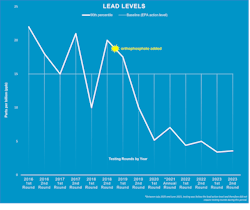The most recent round of testing completed by the Pittsburgh Water and Sewer Authority (PWSA) reflects lead levels well below the state and federal action level of 15 parts per billion (ppb), the authority announced in a press release.
This is PWSA’s seventh consecutive round of testing. 110 water samples were taken at high-risk homes with a known lead service line. The results indicate the continued effectiveness of adding orthophosphate to PWSA’s water treatment process.
“We’re proud that we’ve maintained low lead levels at worst case scenario homes,” said PWSA CEO Will Pickering. “These results continue to demonstrate that we’re protecting all of our customers from the risk of lead in drinking water.”
Since 2016, PWSA replaced over 10,778 public lead service lines and over 7,578 private ones at no direct cost to customers. It is now more than halfway toward its goal of replacing all public lead lines in its service area. Low-interest loans and grants that do not have to be repaid make it possible to expedite this work. PWSA hopes to replace all lead pipes by 2026.
Orthophosphate as corrosion control
In April 2019, PWSA began adding orthophosphate to reduce lead levels in drinking water while continuing to replace thousands of lead service lines.
Adding orthophosphate to the treatment process requires constant monitoring and testing to ensure it is working effectively to protect against lead. Samples are taken from around the system every week, including lead monitoring stations, hydrants, and controlled testing points. Analysts look at lead levels, as well as orthophosphate and pH levels and other markers that influence overall water quality.
PWSA plant and field operators, water quality experts, engineers, and data managers constantly review information collected in the field to ensure that PWSA’s drinking water meets all state and federal regulations, and our customers receive reliable, high-quality water.




